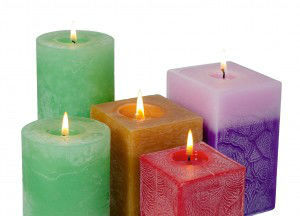
Are you in love with your scented candles? If so, this, unfortunately, is an affair worth ending. While they may smell nice and create a relaxing environment, the health hazards associated with burning them are anything but tranquil.
The following are a few of the ways that scented candles can degrade your indoor air quality.
Most conventional candles – scented and unscented – are made from paraffin, a petroleum product. When they are burned, numerous toxic compounds are released into the home. These include acetone, benzene, ethanol, naphthalene, styrene and toluene. Many of these compounds have been found to be carcinogenic.
When paraffin – and some other types – of candles are burned, they emit soot into the air. If you burn candles indoors frequently enough, black soot can make its way into your home’s ventilation system. It can also stain walls and upholstery. Any flame that is burning bright and white is emitting soot; a flame that does not emit soot is blue.
The effects of candle soot have been compared to the effects of diesel soot, and can be dangerous especially for young children, elderly individuals and those with respiratory conditions.
The chemicals used to create the scents of many candles – especially those with a potent fragrance – emit volatile organic compounds (VOCs), which, according to the EPA, can lead to headaches, nausea, eye, nose and throat irritation and central nervous system damage, along with potentially aggravating existing heart and respiratory conditions.
Some candles contain metal wires within the wicks to make them stand upright, and some of these wicks have been found to contain lead. While manufacturing candles with the use of lead is illegal in the US, some imported candles may still contain this dangerous metal. If your candle wick stands upright, chances are there is a wire inside, and lead is a possibility.
A safer alternative to paraffin candles is to switch to unscented beeswax or soy candles. However, burning any kind of candle in an enclosed, unventilated space may cause respiratory irritation. According to Dr. George Thurston of New York University School of Medicine, “just lighting a match to start a candle creates sulfur pollution in the air. It’s one of the big sources of sulfur in the indoor environment.”
 Dr. Thurston adds, “you ought to try to minimize your exposure to paraffin wax candles. And when you light any kind of candle, you might turn on the exhaust fan; even if it ruins the mood, it vents out the fumes.”
Dr. Thurston adds, “you ought to try to minimize your exposure to paraffin wax candles. And when you light any kind of candle, you might turn on the exhaust fan; even if it ruins the mood, it vents out the fumes.”
If you choose to burn candles in your home, select beeswax or soy varieties, and make sure you have some ventilation in the room. Trim the wick to a quarter of an inch, and do not allow the candles to burn for more than one continuous hour before letting them cool. For a healthier alternative, consider aromatherapy using an essential oil diffuser.
-The Alternative Daily
Sources:
http://www.naturallifemagazine.com/9906/candles.htm
http://www.cnn.com/2009/HEALTH/08/21/candles.air.pollution/index.html?eref=rss_health
http://www.lead.org.au/lanv7n4/L74-9.html
http://www.greenamerica.org/livinggreen/candles.cfm
http://www.epa.gov/waste/nonhaz/municipal/backyard/health.htm#vocs

